These homemade buttermilk biscuits are soft and buttery with hundreds of flaky layers. This biscuit recipe only requires 6 simple ingredients and they’re ready in about 35 minutes.
I originally published this recipe in 2017 and have since added new photos, a video tutorial, and more helpful success tips.
One reader, Marcia, commented: “Finally, a biscuit recipe that worked for me. I especially appreciated the notes which, in fact, had me change some things I had been doing. The detail at all levels, both visual and written, is very helpful. ★★★★★“
Another reader, Maggie, commented: “One of my favorite biscuit recipes! They are so consistently flaky and delicious, every single time! ★★★★★“

Biscuits. Let’s do it BIG. Big as in mega flaky, mega fluffy, mega layers, mega golden brown, and mega buttery. It’s quite serendipitous that this “side dish” may taste even more remarkable than the main event. No, no… it WILL taste more remarkable. Just look at these buttery layers! Nothing can compete.
What are Biscuits?
The term “biscuits” has different meanings depending where you live in the world. In the U.S., biscuits are similar to a dinner roll, but are denser and flakier because they aren’t (typically) made with yeast. Since there’s usually no yeast involved and the rising agent is either baking soda, baking powder, or both—biscuits are considered a quick bread, like banana bread and no yeast bread. In other parts of the world, “biscuits” are more like cookies or scones.

6 Key Ingredients in Buttermilk Biscuits
You need just 6 basic ingredients for my homemade biscuits recipe:
- All-purpose Flour
- Baking Powder
- Salt
- Cold Butter
- Cold Buttermilk
- Honey
With so few ingredients, it’s important to reach for quality ingredients and avoid any substitutions. Notice the emphasis on cold? See tip #1 below.


Success Tips for the Best Homemade Biscuits
Let me share what I’ve learned in the world of homemade buttermilk biscuit recipes. I’ve made plenty of mistakes so you don’t have to. These tried-and-true tricks will turn your flat, dry biscuits into the best biscuits ever. And that’s a guarantee.
- Cold Fat: For flaky layers and pockets, use cold butter. When little pieces of butter melt as the biscuits bake, they release steam and create little pockets of air–this makes the biscuits airy and flaky on the inside while remaining crisp on the outside. It’s the same thing that happens when making these ham & cheese scones.
- Buttermilk & Honey for Flavor: Real buttermilk and teeny drizzle of honey balance out the salt. Buttermilk creates the most tender biscuit! If you’re interested, I have plenty more on this topic in my Baking with Buttermilk post (including a DIY buttermilk substitute recipe).
- Don’t Over Mix: Never overwork biscuit dough. Overworking and over-handling biscuit dough will result in tough, hard, and flat biscuits. Mix the ingredients together *just* until combined. Dough will be crumbly; that’s normal.
- Flatten & Fold Method: The most important step of all is folding the dough together. Turn the scrappy dough out onto a work surface and flatten it with your hands. Form into a rectangle. More below.
- Don’t Twist the Biscuit Cutter: When cutting the dough with a biscuit cutter, do not twist the cutter. Press the cutter down into the dough firmly. Twisting it will seal off the biscuit edges, preventing the biscuits from rising.
- Bake Close Together: Biscuits rise up nice and tall when they are touching, pressed snuggly against one another in the oven.
How to Fold Biscuit Dough
Flattening and folding biscuit dough creates multiple flaky layers, just as it does when we make homemade croissants, rough puff pastry, mille-feuille, and croissant bread. This step will take you no more than 2 minutes and you’ll be rewarded with the flakiest biscuits in the world. First, shape dough into a rectangle:

Then fold one side into the center:
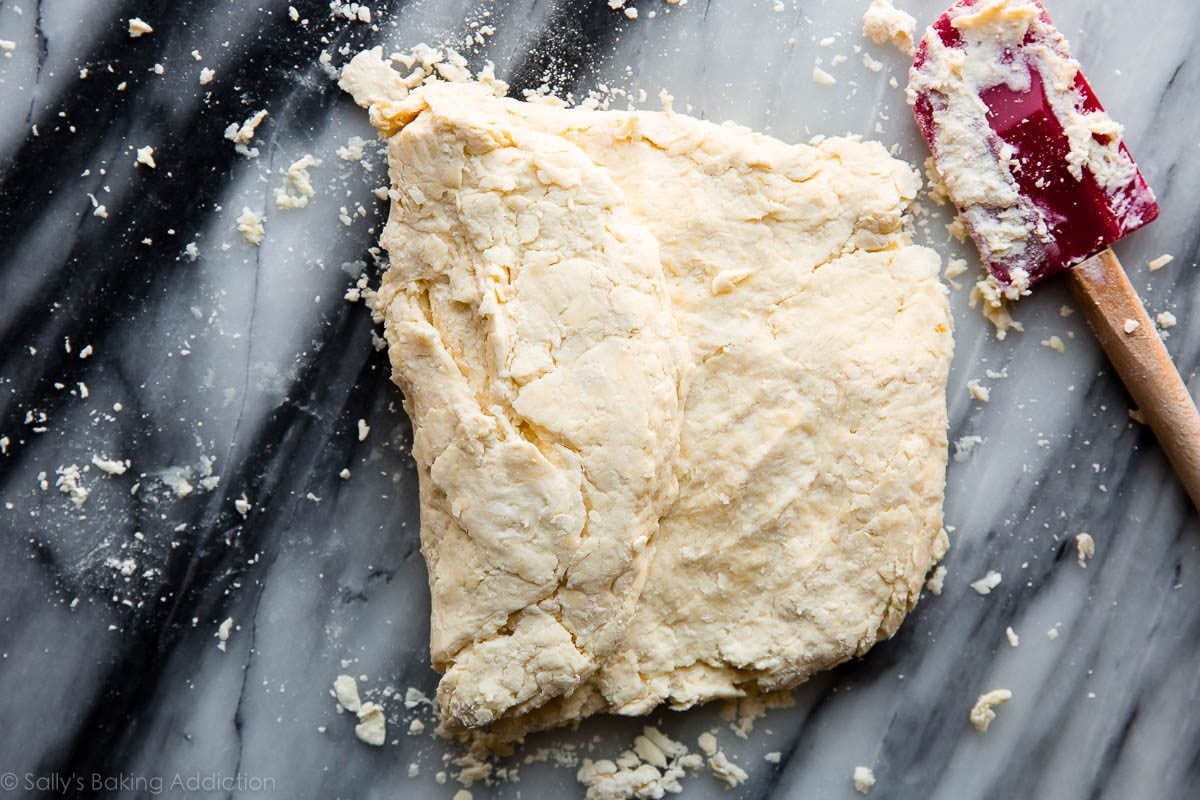
Then the other side:
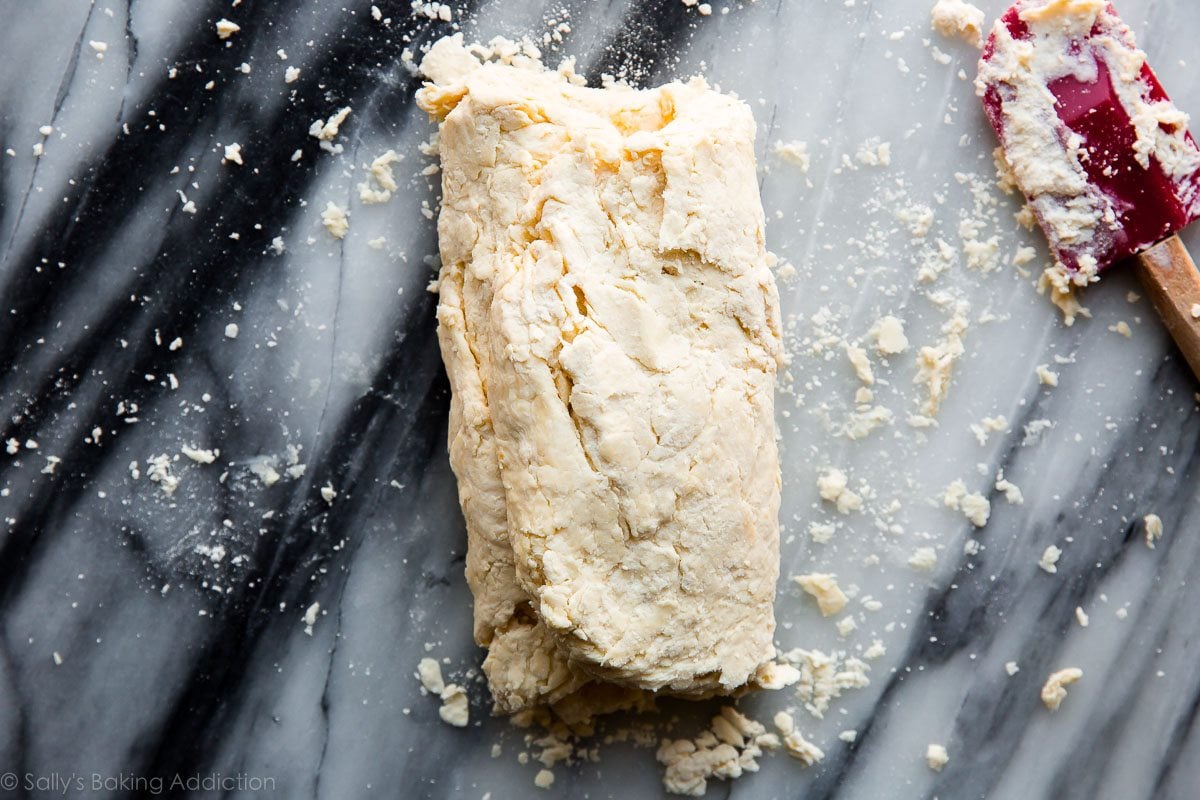
Turn the folded dough horizontal, gently flatten, and begin that folding process 2 more times.
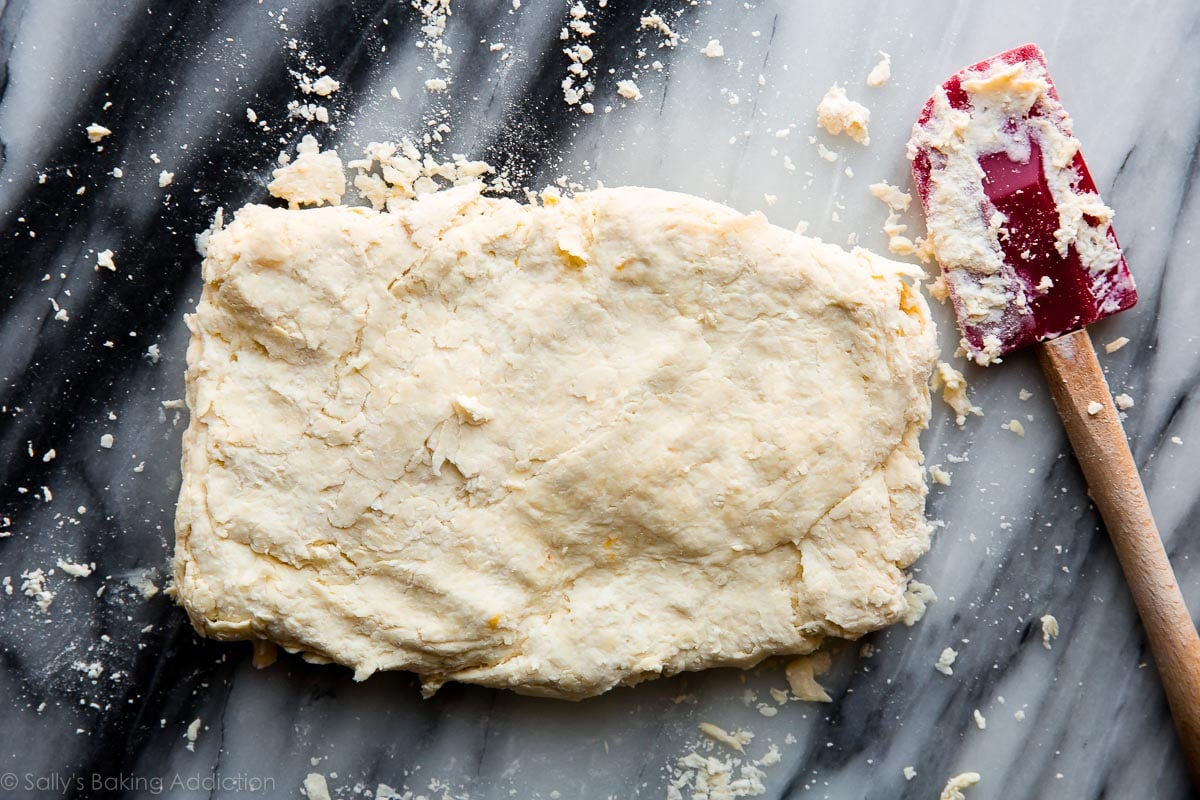
The dough should be about 3/4 inch thick and the biscuits will rise as they bake.
Honey Butter Topping
The honey butter topping is optional, but it will set your biscuits apart from the rest. When the biscuits come out of the oven, brush with a mix of melted butter + honey. You use both ingredients in the biscuit dough, keeping the count at 6 ingredients total.
Serve your homemade biscuits with jam or homemade raspberry sauce, or biscuits and gravy—I love this particular recipe. Or a swipe of homemade honey butter really kicks it up a notch!
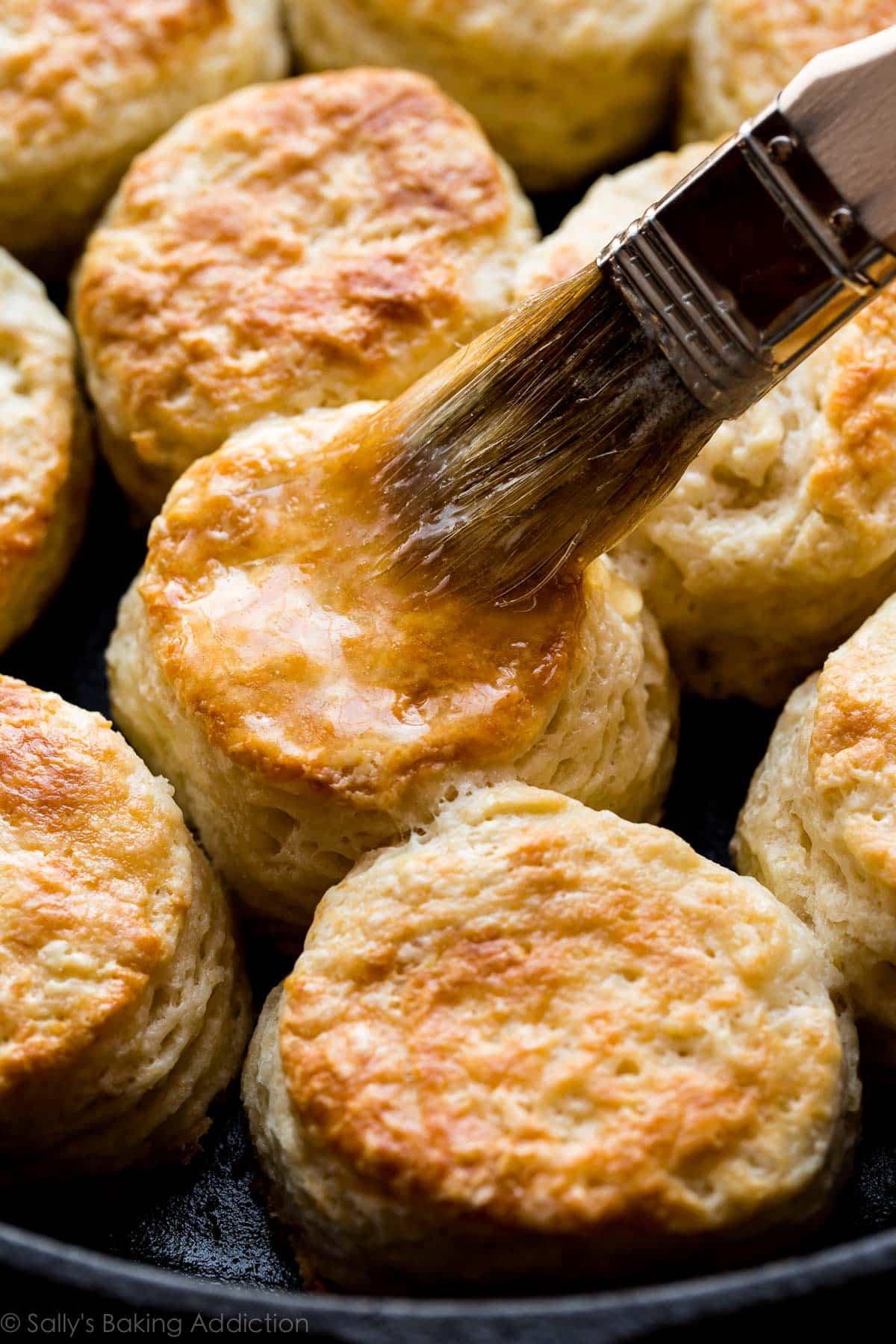
Biscuit Variations
I bake biscuits often, and use the same process and success tips when making all of my favorite variations including cheddar biscuits, everything bagel biscuits, and zucchini biscuits. I also make biscuit-topped vegetable pot pie and biscuit breakfast casserole. And you can absolutely turn these into dessert with my recipes for biscuit-topped berry cobbler and homemade strawberry shortcake!
I make these biscuits on almost a weekly basis, and what makes them a hit every single time, is the combination of very cold butter and buttermilk. Also, be sure to use the amount of baking powder in the recipe below, or try the baking powder and baking soda combination I explain in the recipe Note.
Bake the biscuits in a cast iron skillet, which helps the edges crisp up beautifully. Additionally, use a pastry brush to coat the tops of the biscuits with a little buttermilk before baking.
You can use a food processor to cut the cold butter into the dry ingredients, but if you do not own one, you can use a pastry cutter instead. A pastry cutter is an extremely helpful baking tool!
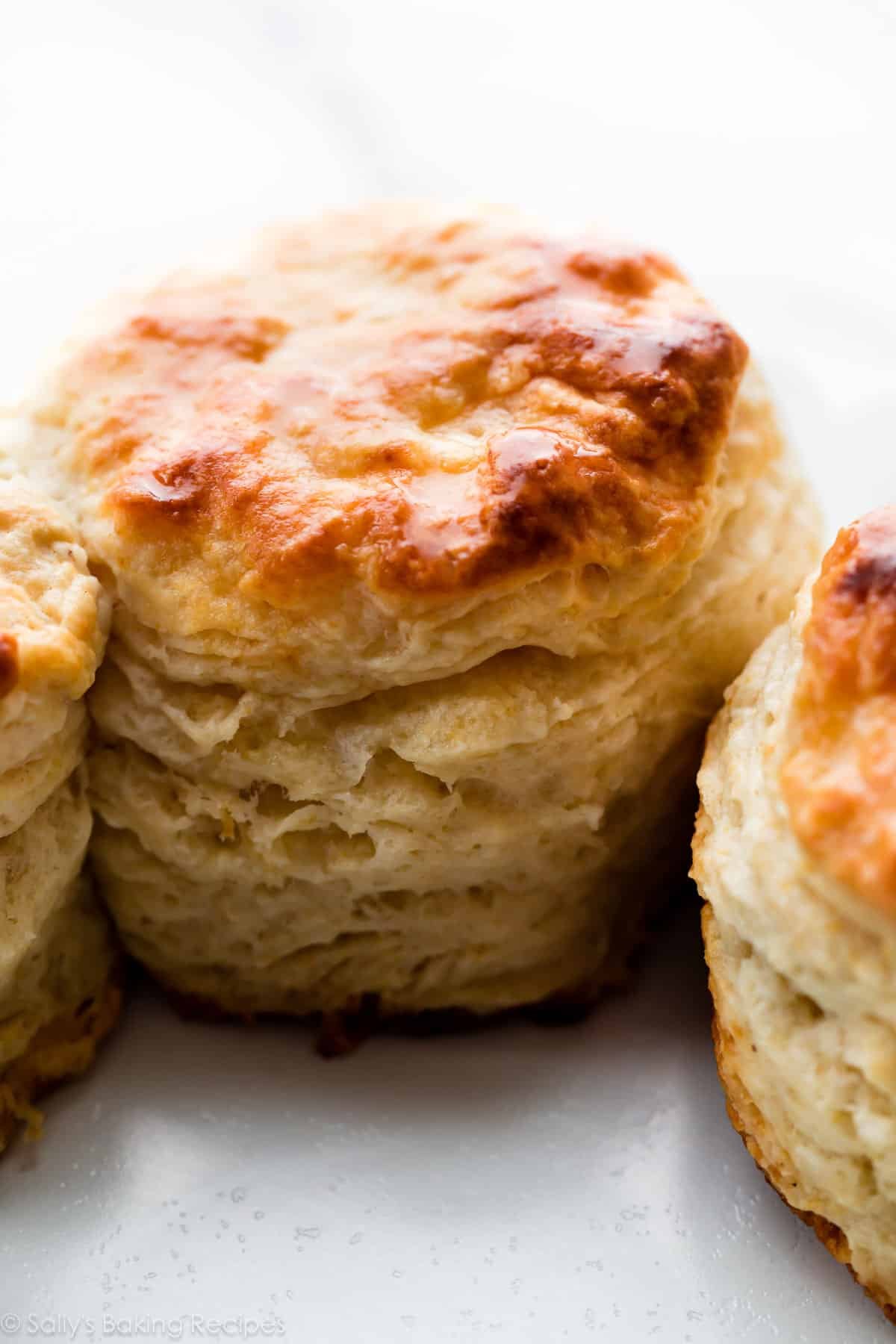
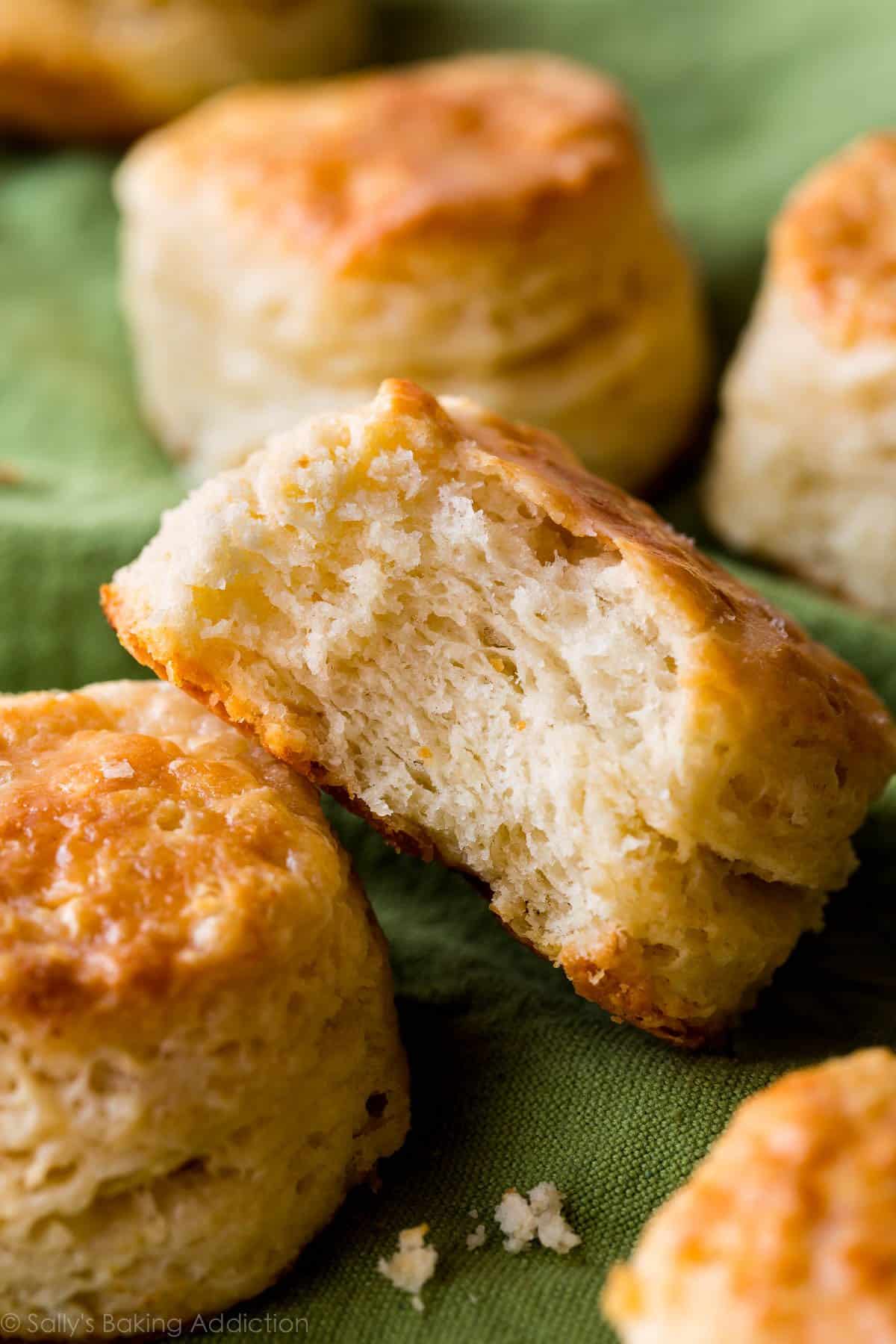
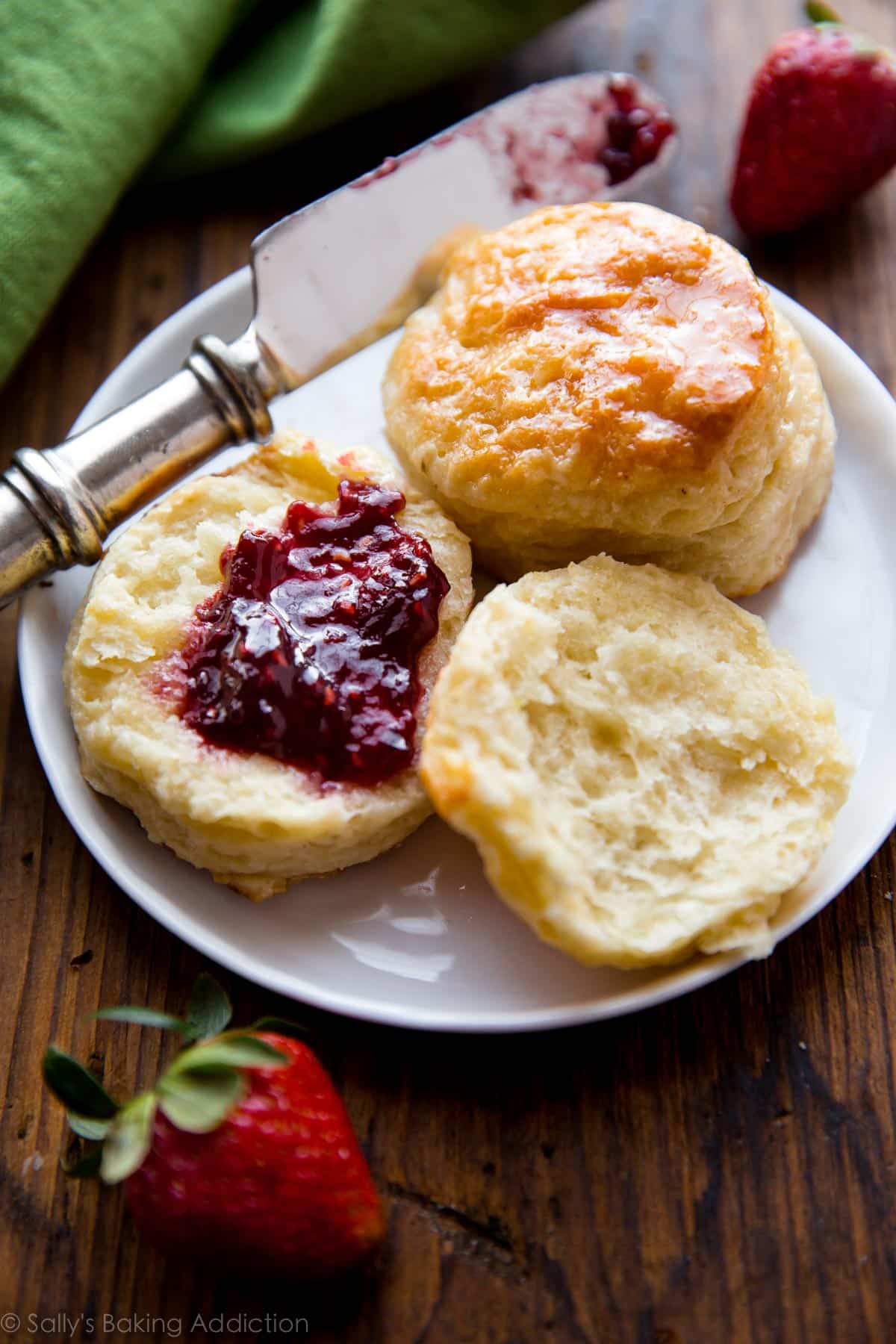
If you enjoy biscuits, try homemade ham & cheese scones and/or my easy no yeast cinnamon rolls.
Even More Biscuits
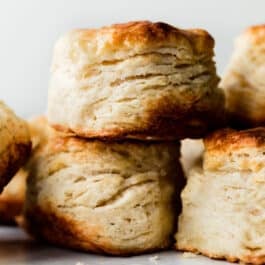
Homemade Buttermilk Biscuits (Popular Recipe!)
- Prep Time: 20 minutes
- Cook Time: 15 minutes
- Total Time: 35 minutes
- Yield: 8-10 biscuits
- Category: Bread
- Method: Baking
- Cuisine: American
Description
These homemade buttermilk biscuits are soft and buttery with hundreds of flaky layers! This biscuit recipe only requires 6 simple ingredients and they’re ready in about 35 minutes.
Ingredients
- 2 and 1/2 cups (313g) all-purpose flour (spooned & leveled), plus more as needed for hands and work surface
- 2 Tablespoons aluminum free baking powder (yes, Tablespoons)
- 1 teaspoon salt
- 1/2 cup (8 Tbsp; 113g) unsalted butter, cubed and very cold (see note)
- 1 cup + 2 Tablespoons (270ml) cold buttermilk, divided
- 2 teaspoons (14g) honey
- optional honey butter topping: 2 Tablespoons melted butter mixed with 1 Tablespoon honey
Instructions
- Preheat oven to 425°F (218°C).
- Make the biscuits: Place the flour, baking powder, and salt together in a large bowl or in a large food processor. Whisk or pulse until combined. Add the cubed butter and cut into the dry ingredients with a pastry cutter or by pulsing several times in the processor. Cut/pulse until coarse crumbs form. See photo above for a visual. If you used a food processor, pour the mixture into a large bowl.
- Make a well in the center of the mixture. Pour 1 cup (240ml) buttermilk and drizzle honey on top. Fold everything together with a large spoon or spatula until it begins to come together. Do not overwork the dough. The dough will be shaggy and crumbly with some wet spots. See photo above for a visual.
- Pour the dough and any dough crumbles onto a floured work surface and gently bring together with generously floured hands. The dough will become sticky as you bring it together. Have extra flour nearby and use it often to flour your hands and work surface in this step. Using floured hands, flatten into a 3/4 inch thick rectangle as best you can. Fold one side into the center, then the other side on top. Turn the dough horizontally. Gently flatten into a 3/4 inch thick rectangle again. Repeat the folding again. Turn the dough horizontally one more time. Gently flatten into a 3/4 inch thick rectangle. Repeat the folding one last time. Flatten into the final 3/4 inch thick rectangle.
- Cut into 2.5 or 3-inch circles with a biscuit cutter. (Tip: Do not twist the biscuit cutter when pressing down into the dough because this seals off the edges of the biscuit which prevents them from fully rising.) Re-roll scraps until all the dough is used. You should have about 8-10 biscuits. Arrange in a 10-inch cast iron skillet (see note) or close together on a parchment paper-lined baking sheet. Make sure the biscuits are touching.
- Brush the tops with remaining buttermilk. Bake for 18-20 minutes or until tops are golden brown.
- Remove from the oven, and then brush warm tops with optional honey butter, and serve warm.
- Cover leftovers tightly and store at room temperature or in the refrigerator for up to 5 days.
Notes
- Make Ahead & Freezing Instructions: Baked biscuits freeze well for up to 3 months. Thaw at room temperature or in the refrigerator, then warm up to your liking before serving. You can also freeze the biscuit dough. Prepare the dough in steps 2 through 4. Wrap up tightly in plastic wrap (plastic wrap is best for freshness) and freeze for up to 3 months. Thaw overnight in the refrigerator, then continue with step 5. Also, after step 4, you can wrap the dough in plastic wrap and refrigerate for up to 2 days before continuing with step 5.
- Special Tools (affiliate links): Pastry Cutter or Food Processor | 2.5- or 3-inch Biscuit Cutter | 10-inch Cast Iron Skillet (or Baking Sheet with Parchment Paper) | Pastry Brush
- Baking Powder: To avoid a chemical aftertaste, make sure your baking powder is labeled aluminum free. I usually use Clabber Girl brand and though the ingredients state aluminum, I’ve never noticed an aluminum aftertaste. Alternatively, you can reduce the baking powder down to 1 Tablespoon and add 1/2 teaspoon baking soda.
- Butter: Cut into 1/2-inch cubes. Keep butter as cold as possible until you need it. I recommend placing the cubed butter in the freezer for about 15 minutes before you begin.
- Buttermilk: You can substitute whole milk for buttermilk if desired. However if you’d like the tangy flavor, which I highly recommend, you can make your own DIY buttermilk substitute. Add 2 teaspoons of fresh lemon juice or white vinegar to a liquid measuring cup. Add enough milk to make 1 cup. (You need 1 cup in the recipe, plus 2 Tbsp for brushing–you can use regular milk to brush on top.) Whisk together, then let sit for 5 minutes before using in the recipe. Whole milk is best for the DIY sour milk substitute, though lower fat or nondairy milks work in a pinch. (In my testing, the biscuits don’t taste as rich or rise quite as tall using lower fat or nondairy milks.)
- Cast Iron Skillet: If your cast iron skillet isn’t well seasoned, I recommend greasing it with a little vegetable oil or melted butter. Brush a thin layer of either on the bottom and around the sides. No need to heat the cast iron skillet before using, though you certainly can. Place in the preheated oven for 15 minutes before arranging the shaped biscuits in it.
- Flavors: Try my flavorful biscuit variations: cheddar biscuits and everything bagel biscuits.
Nutrition
- Serving Size: 1 biscuit
- Calories: 212
- Sugar: 2.4 g
- Sodium: 283.5 mg
- Fat: 9.7 g
- Carbohydrates: 27.5 g
- Protein: 4.1 g
- Cholesterol: 25.4 mg
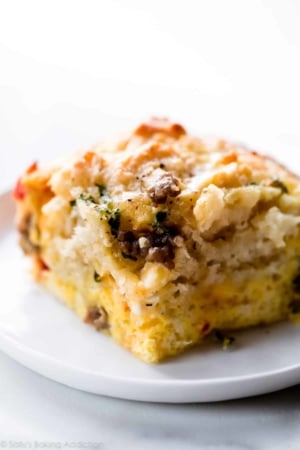
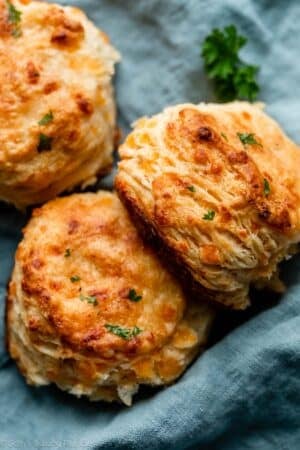
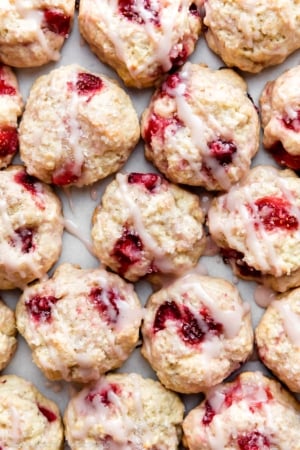
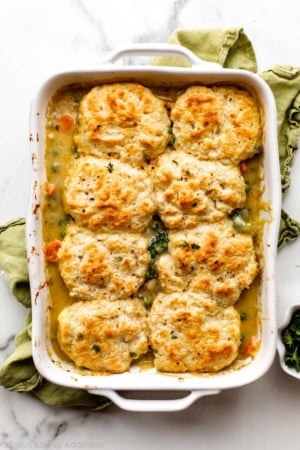





















This recipe is so salty, we couldn’t eat them. They were light and fluffy, so I’m assuming Americans like much saltier food than Brits. I used unsalted butter in the recipe and on them when eaten, If I were to make them again I would leave out the teaspoon of salt as there is already enough sodium in the baking powder. As the recipe stands, it must have the equivalent of the daily sodium allowance in just one or two biscuits.
Does these biscuits freeze well?
Hi Lauri, they do—see recipe notes for details. Enjoy!
Can I cut the biscuits, refrigerate, and then bake 3 days later? If not, any tips for reheating?
Hi Amy, for that amount of time, we’d recommend freezing the cut biscuits instead. If doing that, we do recommend baking them thawed, not frozen. After shaping them in step 4, place them on a plate or in a freezer-friendly container, cover tightly, then freeze for up to 3 months. Thaw in the refrigerator, then bake as directed. Or, you can make the biscuits and reheat in the microwave or oven to your liking. Enjoy!
Such a great recipe! Easy to make and no waiting around for anything to proof. They were so soft and went perfect with the honey.
Sally,
These are almost identical to an old recipe I’ve always used except it calls for lard. Have you ever subbed lard in place of butter? Your folding technique was my missing ingredient LOL. As always, this was another A+ recipe!!!
Hi Stacey, we’re so glad you enjoyed these! We haven’t tested them with lard, but let us know if you do any experimenting.
These turned out perfect!
This was the first biscuits from scratch. I realized the folding you showed is how I prep my sourdough bread. I wonder now why I never made them before. I want to say, these were the BEST biscuits I’ve ever had! Thank you, now I’m going to make pie crust.
can you use different raising agents such as dry yeast and cream of tartar
Hi Daniele, we haven’t tested this recipe that way, so we’re unsure of the conversions. It’s best to stick with this recipe as written.
Can I bake this in a heavy, good quality, oven proof non-stick skillet?
Yes, absolutely. Be sure to grease it with butter or a little oil.
Thank you Sally. Love your recipes and detailed instructions.
I cant use honey, is there something else I can/should substitute in its place?
Hi Christine, regular granulated sugar works in its place in the dough. You can skip the honey in the butter topping, or replace with maple syrup. (Maple syrup would also work in the dough.)
This recipe never fails, is ALWAYS amazing and soooo tasty. Recently I’ve started substituting molasses instead of honey so that my 9 month old can eat them.. I love it! It gives it a twist and makes it taste just a tiny bit seasonal/christmany. Really amazing either way!!
Is it possible to cut the biscuits, freeze them and take them out as needed to bake them from frozen. If so, are any adjustments to the recipe needed? Thanks so much!
Hi Lucinda, you can freeze the shaped biscuits, but we do recommend baking them thawed, not frozen. After shaping them in step 4, place them on a plate or in a freezer-friendly container, cover tightly, then freeze for up to 3 months. Thaw in the refrigerator, then bake as directed.
I made some mistakes and didn’t follow the directions perfectly because I didn’t have a pastry cutter or food processor and it still came out just fine
Weekly must have! After the first time making and eating these biscuits, it has become a staple and we make them almost weekly. Easy to make and way better than any biscuit you’ll find at the store.
These are delicious! I made them today for the first time. I always watched my grandma making biscuits as a child. She would be proud!
Question, could you just sub self-rising flour in this recipe 1:1 for AP flour and eliminate baking powder? Would you also eliminate salt if using self-rising flour?
Hi Rhetta, we’re so glad you loved these biscuits! We don’t recommend using self raising flour here. It’s not always a 1:1 swap with all-purpose, so it’s better to use the combination of all-purpose flour and baking powder as written.
Easy and amazing!
The buttermilk recipie is great….this works at high elevation, sometimes I don’t have unsalted butter so I leave out the salt called for in the recipie.
I’m not much of a bread maker, but these are absolutely delicious….my go to biscuit recipe from now on!!
Wow! What a delicious Buttermilk Biscuit recipe! Love the crunch on the outside . Thank you for this wonderful recipe.
Made these last night. My second time making biscuits and your recipe has now converted me to biscuit making! Served them with salted butter and my homemade muscadine preserves!
Sally I love your recipes so much! Thank you for all the cookie and biscuit recipes!!!! You’re loved and treasured!
-Jack
Can I double this recipe or would I be better off making it twice?
Hi Jenna, for best results, we recommend making two separate batches. Hope you enjoy the biscuits!